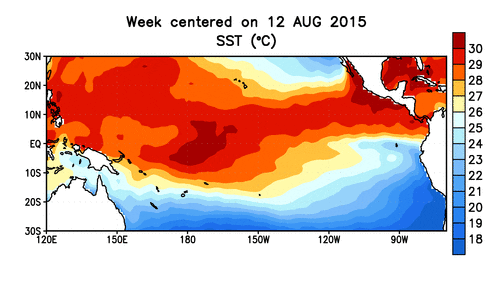
Hurricane Patricia was a surprise. The eastern Pacific hurricane strengthened explosively before hitting the coast of Mexico, far exceeding projections of scientists who study such storms.
And while the storm’s strength dissipated quickly when it struck land, a question remained. What made it such a monster?
Explanations were all over the map, with theories that included climate change (or not), and El Niño.
But the answer is more complicated. The interplay of all the different kinds of warming going on in the Pacific at the moment can be difficult to sort out and, as with the recent hurricane, attributing a weather event to a single cause is unrealistic.
Gabriel Vecchi, head of the climate variations and predictability group at the geophysical fluid dynamics laboratory of the National Oceanic and Atmospheric Administration in Princeton, N.J., likened the challenge to the board game Clue.
“There’s all these suspects, and we have them all in the room right now,” he said. “The key is to go and systematically figure out who was where and when, so we can exclude people or phenomena.” Extending the metaphor, he noted that criminal suspects could work together as accomplices, and there could be a character not yet known. And, as in all mysteries, “You can have a twist ending.”
At the moment, the world’s largest ocean is a troublesome place, creating storms and causing problems for people and marine life across the Pacific Rim and beyond. A partial list includes the strong El Niño system that has formed along the Equator, and another unusually persistent zone of warm water that has been sitting off the North American coast, wryly called “the Blob.”
And a longer-term cycle of heating and cooling known as the Pacific Decadal Oscillation may be switching from a cooling phase to a warming phase. On top of all that is the grinding progress of climate change, caused by accumulation of greenhouse gases generated by human activity.
Each of these phenomena operates on a different time scale, but for now they appear to be synchronized, a little like the way the second hand, minute hand and hour hand line up at the stroke of midnight. And the collective effects could be very powerful.
Although they interact with one another, each of these warming events is being blamed for specific problems.
“The Blob” has been associated, among other effects, with the unusually dry and warm weather in the western United States. Out in the ocean, the nutrient-poor warmer waters of the Blob — about four degrees Fahrenheit higher than average — are disrupting the food web of marine life. Some species of fish are showing up where they are not expected, including tropical sunfish off the Alaska coast, and an unusual number of emaciated sea lion pups and Guadalupe fur seals are being found stranded on California shores.
The warm water has also been linked to unprecedented harmful algal blooms along the coasts that have rendered shellfish toxic and shut down shellfish fisheries in Washington, Oregon and California. “A single clam can have enough toxins to kill a person,” said Vera L. Trainer, the manager of the marine biotoxin program at NOAA’s Northwest Fisheries Science Center in Seattle. Officials also ordered the largest closure of the state’s Dungeness crab fishing.
“It’s really worrisome,” Dr. Trainer added. “If this is a single event that then goes away and we can forget about it down the road, it’s O.K. If it’s a window into the future, it’s not a good future.”
Read more: The Pacific Ocean Becomes a Caldron
The Latest on: Pacific Ocean
[google_news title=”” keyword=”Pacific Ocean” num_posts=”10″ blurb_length=”0″ show_thumb=”left”]
via Google News
The Latest on: Pacific Ocean
- Feed has no items.
via Bing News










